July 1, 2017 9:00 pm
8 Frequently Asked Space-Related Questions (Part 1 of 2)
Answers on black holes, how stars live and die, and the likelihood of an asteroid wiping us out.
Today’s guest blog post is by StarTalk intern Kirk Long. Kirk is majoring in physics while minoring in mathematics and piano at Idaho State University. He spends his weekends working at the largest public observatory in Idaho, the Bruneau Sand Dunes State Park Observatory, where he gives educational astronomy presentations and operates various large telescopes for the public.
As a physics major who works teaching science, I get a lot of space-themed questions directed at me. I’m perhaps a little bit partial, but I think space and astrophysics are the sexiest fields in science (and you might agree — you are reading StarTalk after all). Family and friends frequently direct people to me to answer their burning space, physics, or mathematics questions, and dinners quickly turn deep when I’m around (as Carl Sagan famously said, “if you want to make an apple pie from scratch, you must first create the universe”). During my summers off from school I help coordinate and teach summer STEM camps for kids, and one of the things I run in my classroom is a question board, where young students can ask anything science related and I do my best to answer it. On weekend nights I run telescopes and give lectures at an observatory, and after my lectures there I try to do a short Q&A session as well. Over time, I’ve noticed that there are some questions that emerge more often than others, and I’ve written them up below.
1: Will our sun explode?
This is a pretty common question I get, and although many people falsely believe our own Sun will go supernova, in reality its death will be much slower and less dramatic. Stars basically have two general life-plans (which are outlined in the graphic below). Massive stars (at least 8 solar masses) are the more “exciting” type — at the end of their lives they explode in spectacular supernovas, spewing their guts across the cosmos and leaving behind black holes or neutron stars where their cores once were. These massive stars are much more unstable when compared to our own star, and they live shorter and more violent lives — for this reason it’s actually much better for life on Earth that we have a “boring” star. Average stars like our Sun follow a less dramatic process — as they use up the remaining bits of hydrogen fuel in their cores they slowly become inert and contract. Fusion doesn’t stop, however, and instead hydrogen fusion switches on in “shells” above the core closer to the star’s surface, causing the star to bloat and expand. Some less massive stars can also begin to fuse helium in their cores or go through “helium flashes”, where helium fusion briefly takes places in shells around the core. Eventually (in about 5 billion years or so) our star will have expanded enough that its radius will probably encompass the Earth’s current orbit (so hopefully by then we will have figured out how to get off this rock). In addition to swallowing the inner planets, the increased solar wind from this red giant will blow away Saturn’s rings, and it will eventually start to blow layers off the star itself. Eventually most fusion will cease, and in its death throes the star will star a cycle of contraction and expansion, puffing off layers of itself into space. This cycle of expansion and contraction is a result of intermittent fusion reactions taking place within the star. A star is a constant balance between gravity attempting to squish everything together and nuclear fusion attempting to blow it apart, and with fusion stopped gravity will temporarily have the upper hand, causing the star to contract. Once it contracts sufficiently however, the fusion engine will sputter back to life and blow the star back outwards, causing an intense solar wind that will blow away a gaseous layer of the star into space. This process of contraction and expansion will continue until all that remains is a dense white dwarf core, and from there our star (and other ordinary stars like it) will slowly dissipate their heat into space over trillions of years, dimly glowing like cosmic embers.

This graphic (courtesy of NASA) shows the two main paths stars can follow. Whether a massive star ends up leaving behind a black hole or a neutron star depends on the mass of its core, with the most massive stars leaving behind black holes.
2: Are we really made of star stuff?
To answer this, consider the life cycle of the more massive stars I mentioned earlier. These stars are capable of fusing heavier elements in their cores, but even they have their limits. The highest element capable of being created under “normal” conditions in a stellar furnace is iron (#48 on the periodic table), and when these massive stars get to this element they begin their much more violent deaths. To fuse iron into anything else requires an input of energy, so once these larger stars’ cores are turned into iron fusion stops. The core is under immense gravitational pressure, however, and with no more energy being released from fusion reaction gravity wins and dramatically contracts the core at a breakneck pace, leaving the outer layers suddenly suspended. These outer layers fall onto the surface of the now ultra-dense core at immense speed and pressure, and in this instant a supernova is born. Normally only a small percentage of a star is actually undergoing fusion at any given time, but under these intense conditions a much greater percentage undergoes fusion, starting a chain reaction that literally rips the star apart. It’s under these immense pressures that all of the universe’s heavier elements are created, and it’s in the resulting explosions that these elements are propagated outwards into the universe. You may have heard that you’re made of star stuff, and that’s where that saying comes from. The simplest two elements on the periodic table are hydrogen and helium, and in the early universe (before the first stars and galaxies) it makes sense then that the elements most prevalent were hydrogen and helium (accounting for about 70% and 25% of mass in this early universe, respectively). Elements vital to life (like carbon) were nonexistent in the early universe, and they had to be forged in the crucibles of early, supermassive stars who would later spew them out across the cosmos in their death throes. Matter and energy can neither be created nor destroyed, they just change forms, and these massive supernovae are truly an astronomically poetic expression of cosmic reinvention.
3: What exactly are black holes, and why are they so black?
Astronomers have sometimes been accused of being a bit unimaginative when naming things, and black holes are no exception. The name really is apt, however, and the reason they are so black is key to why they’re so fascinating to scientists and the public alike. A black hole is perfectly black because not even light itself can escape a black hole’s gravitational field. They’re incredibly important to the evolution of the universe — at the center of every galaxy lies a supermassive black hole that everything else (including our own solar system) spins around. They’re also incredibly fascinating because we know so little about them. Once data passes what we call the event horizon (the edge between light and dark, where the gravitational field begins to overcome even the speed of light itself) it is lost forever into the singularity. Black holes will probably remain one of our universe’s greatest mysteries for eons to come, and we may never be able to unlock their secrets as traveling into a black hole probably wouldn’t be a great idea. One common misconception (and a fun party fact) about black holes is that they don’t suck — if you were to replace our sun with a black hole of identical mass the Earth would not be sucked in. We would still die, to be sure (sunlight is pretty important to us) but the Earth would continue to orbit this black hole in the same orbit it has today.
4: What are the chances of an asteroid hitting us, and how big would one have to be to wipe out all life?
The short answer is pretty low, and we’d almost certainly see it coming if one was going to impact us so hopefully we would be able to act to prevent another extinction level event. The risk goes up a little for unforeseen smaller impactors, which wouldn’t wipe us out but could still be powerful enough to inflict significant damage if they were to land in a metropolitan area. We think that the object that precipitated the extinction of the dinosaurs was about 6-8 miles in wide, but even an object that big wouldn’t be enough to wipe out everything. The Cretaceous-Paleogene extinction event wiped out about 75% of all plant and animal life on Earth, including the dinosaurs, but many smaller species were able to survive. The oldest found placental mammal (one of our oldest direct ancestors) lived among the dinosaurs before they went extinct. With the dinosaurs dead and gone, however, this tiny rodent and other mammals were able to diversify, expand, and fill the environmental niches left behind. It’s actually pretty good for us that the dinosaurs were wiped out, because we probably exist as a result. To wipe out all life on Earth you’d need a much bigger rock than what killed the dinosaurs. One astronomer at the University of Colorado estimated that an impactor around 60 miles wide would probably hit with enough energy to vaporize all of humanity, but even then some life would probably survive somewhere. To truly sterilize the Earth, you would need an impactor capable of melting the entire crust, and the last time that happened was when an early planetoid collided with the Earth more than 4 billion years ago, leading to the formation of the moon, so it’s pretty unlikely.
Check back next week for the second part of this list, which covers aliens, dark matter, dark energy, and why Pluto’s not a planet regardless of how much it clashes with your childhood.
Get the most out of StarTalk!
Ad-Free Audio Downloads
Priority Cosmic Queries
Patreon Exclusive AMAs
Signed Books from Neil
Live Streams with Neil
Learn the Meaning of Life
...and much more

 Become a Patron
Become a Patron

